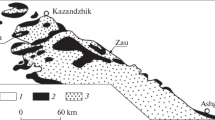Abstract
The magnetostratigraphical study of Hungarian loesses has been going on for several decades. In spite of a number of attempts, partly in international cooperation, we could not find reversals within the Brunhes Epoch. This is unambiguously associated with the particular characteristics of loess formation and with the relatively short duration of paleomagnetic intervals within this epoch.
On the basis of magnetic measurements in the paleosols of the comprehensively studied Basaharc loess profile and presenting the Hódmezövásárhely profile analysed by P. Márton (1979), the application of the paleomagnetic methods for stratigraphic subdivision is presented. This relies on the evaluation of random fluctuations of and tendencies in inclination and declination, of values substantially deviating from the normal but showing no reversal. It is to the purpose to apply this method in conjunction with thermoluminescence chronological techniques.
Similar content being viewed by others
References
Heller, F.; Meili, B.; Wang, J.; Li, H.; Liu, T.: Magnetization and sedimentation history of loess in the Central Loess Plateau of China. pp. 147–163. In: Liu, T. (ed.), Aspects of loess research. China Ocean Press, Beijing 1987.
Kukla, G.; An, Z.: Loess stratigraphy in central China. Paleogeography, Paleoclimatology, Paleoecology 72, 203–225 (1989)
Márton, P.; Pécsi, M.; Szebényi, E.; Wagner, M.: Alluvial loess (infusion loess) on the Great Hungarian Plain — its lithological, pedological, stratigraphical and paleomagnetic analysis in the Hódmezövásárhely Brickyard exposure. pp. 539–555. In: Pécsi, M. (ed.), Studies on Loess. Akadémiai Kiadó, Budapest 1979.
Pécsi, M.: Lithostratigraphical subdivision of the loess sequences in Hungary. Földrajzi Közlemények 23 (99), 3–4, 217–230 (1975) (in Hungarian with English summary)
Pécsi, M.: Quaternary and Loess Research. Akadémiai Kiadó, Budapest. 375 (in Hungarian with English summary)
Pécsi, M.; Pevzner, M.A.: Paleomagnetic measurements in the loess sequences at Paks and Dunaföldvár, Hungary. Földrajzi Közlemények 22, (98) 3, 215–219 (1974)
Pécsi, M.; Pécsi-Donáth, É.; Szebényi, E.; Hahn, Gy.; Schweitzer, F.; Pevzner, M.A.: Paleogeographical reconstruction of fossil soils in Hungarian loess. Földrajzi Közlemények 25 (101), 1–3, 94–128 (1977)
Author information
Authors and Affiliations
Rights and permissions
About this article
Cite this article
Balogh, J. Paleomagnetic changes within the Brunhes Epoch in the Basaharc loess profile, Hungary. GeoJournal 36, 251–254 (1995). https://doi.org/10.1007/BF00813180
Issue Date:
DOI: https://doi.org/10.1007/BF00813180




